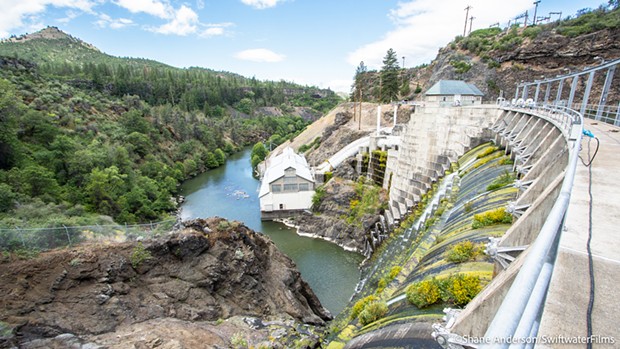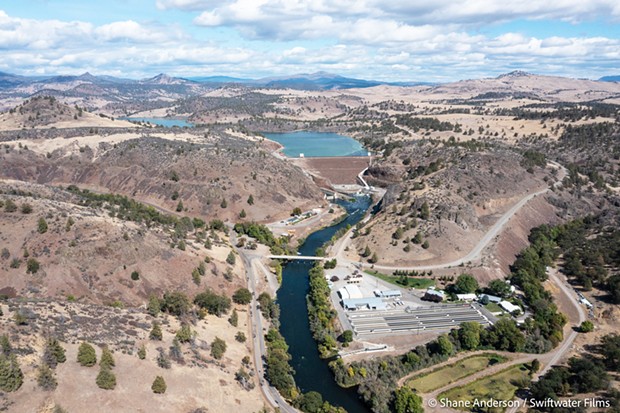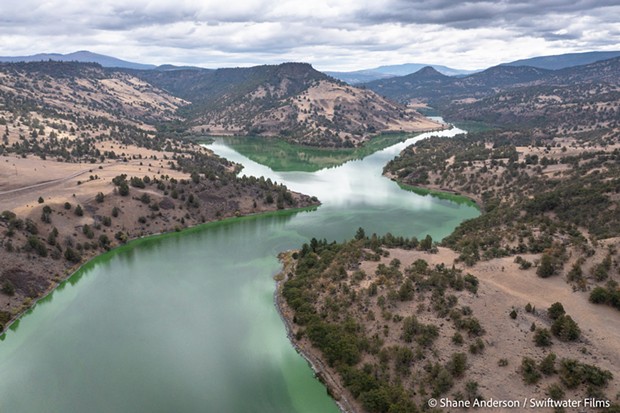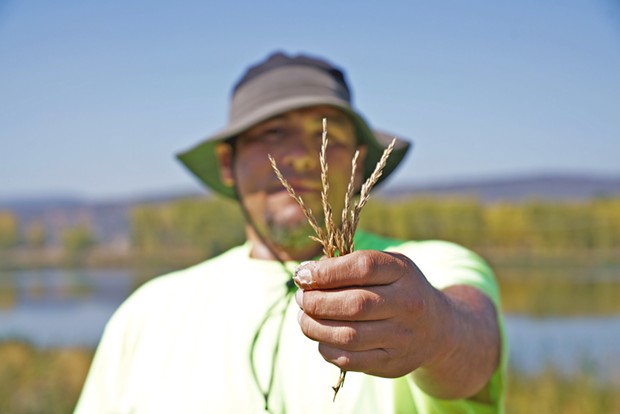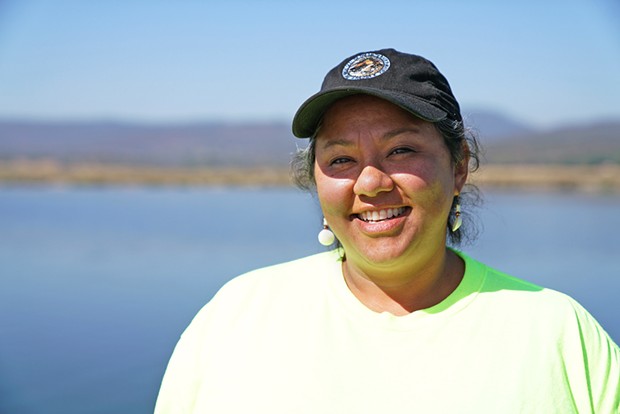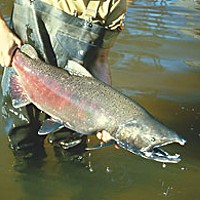Undamming (and Restoring) the Klamath
A close-up look at the nation's largest dam removal and restoration effort
By Thadeus Greenson [email protected] @ThadeusGreenson[
{
"name": "Top Stories Video Pair",
"insertPoint": "7",
"component": "17087298",
"parentWrapperClass": "fdn-ads-inline-content-block",
"requiredCountToDisplay": "1"
}
]
Much of the focus on the largest dam removal and restoration effort in the nation's history has been on extraction — the removal of the four dams that have choked flows on the Klamath River for more than a century.
And from a sheer extraction perspective, the breadth of the project is breathtaking, as it will see a combined 500 feet of dams taken down over the course of about 18 months, with 100,000 cubic yards of concrete, 1.3 million cubic yards of excavated soil and 2,000 tons of demolished steel pulled from the river's path. And that work will free an estimated total of 15 million cubic yards of sediment — enough to fill more than 4,500 Olympic-size swimming pools — that is currently trapped in reservoirs.
But to fully understand the historic dam removal and restoration effort that has broken ground this year after decades of advocacy efforts led by local tribes whose culture, sustenance and economies depend on the river's health, it's better to look at it as a massive surgery. After all, a surgeon doesn't simply walk in, cut someone open, extract a malignant tumor and leave. Rather, there's extensive pre-operation procedures to prepare the patient and set up monitoring systems, then the surgery itself and then post-op recovery, therapy and evaluations.
In the case of the Klamath River, a living ecosystem, albeit a sick one, plagued by poor water quality and clogged arteries that have pushed salmon populations to the brink, that means extensive site preparation work to enable the mechanics of dam removal and lay the foundation for restoration efforts, then come the dam removals themselves and, finally, years of active management aimed at restoring the river to health.
Last month, project officials held a virtual press conference to announce they'd officially "broken ground," and work has begun to restore the lower Klamath River to a free-flowing form by the close of 2024.
Preparation
Perhaps equally impressive as what the project will see taken out of the Klamath River basin is what will be put back in: More than 17 billion native seeds and 300,000 tree and shrub plugs and starts that will be used to replant more than 2,000 acres of land currently covered by three reservoirs created by the dams. Because one does not simply walk into a nursery and buy 17 billion seeds and 300,000 starts, it's a project component that has been years in the making.
To help guide this massive effort, the Yurok Tribe recruited Senior Riparian Ecologist Joshua Chenoweth, a former television producer who earned a masters from the University of Washington in restoration dam removal and served as the restoration botanist for the Elwha Ecosystem Restoration project on the Olympic Peninsula, which saw the Elwha and Glines Canyon dams removed from the Elwha River, which at the time was the largest dam removal project in the nation's history.
By the time Chenoweth joined the Klamath effort in September of 2019, he said the Yurok Tribe had already been working to collect seeds from native plants in and around the Klamath basin for more than a year. But seed collection is a slow, arduous process, and there's simply no way it alone can gather the bulk needed for a planting effort of this magnitude.
As such, Resource Environmental Solutions, the company hired by the nonprofit Klamath River Renewal Corporation to lead the restoration effort, contracted with a number of farms and nurseries that specialize in seed propagation. One of those, for example, Benson Farms in Warden, Washington, worked to propagate a strain of bluebunch wheatgrass native to the Klamath basin, taking a "handful of seed" and growing it repeatedly to harvest the "hundreds of thousands of pounds" of seed the project demands.
In addition to the seed collection effort, Chenoweth said his crews are also working diligently to remove non-native species from around the dams and reservoirs, trying to create 50- to 100-foot buffers aimed at preventing the invasive Medusa head, star thistle and cheatgrass from taking over the restoration sites. Chenoweth said this has been a years-long effort consisting of using string trimmers to cut down invasives in the area before they go to seed and, in some cases, going hands-on.
"The crew will get down on their hands and knees and pull," he said, adding that some species — like Himalayan blackberry — require targeted use of herbicides. "This work really boosts the chances for native species to dominate this new landscape."
Dave Coffman, RES' Northern California director, meanwhile, said his crews have been focused on water quality and terrestrial wildlife monitoring plans, as well as implementing an aquatic resources management plan. This means readying 10 water monitoring stations to test the river's water temperature and dissolved oxygen and Ph levels. Monitoring began Jan. 1, he said, to provide baseline numbers and will continue years into the future.
"We started early to try to get processes and procedures in place because water monitoring of this scale is not an easy deal," he said, adding that it's a collaborative effort, with the Karuk Tribe doing a lot of the water station maintenance, the RES team doing data processing and reporting and the Klamath Tribes in Oregon processing "grab" samples.
On the wildlife front, he said crews are doing surveys for bald and golden eagles, adding that nesting sites have been well identified at this point and are just being monitored for use and potential impacts. Biologists are also walking construction sites to scout for nesting birds, Coffman said, while crews also walk silt fences — or temporary barriers to prevent runoff into the river —to scout for trapped reptiles or amphibians, helping any they find to make their way safely down to the river. Coffman said RES crews are doing some "some fish exclusion work," erecting block nets to keep salmonids out of construction areas.
But perhaps the most delicate task comes with the aquatic resources management plan, which Coffman said aims to relocate a total of 600 Lost River and shortnose suckers — endangered species that live up to 30 years and are considered culturally sacred by the Klamath Tribes, much like salmon are to the Karuk and Yurok tribes — from behind the J.C. Boyle, Copco and Iron Gate dams. While these fish have made their homes in the reservoirs, they wouldn't be able to survive in the free-flowing river.
Planning and testing efforts have been underway for months, but Coffman said the real work will begin in a couple of weeks, when three-person crews will take to the reservoirs in boats, dipping 300-foot-long nets into the water for two-hours at a time before checking them, transferring any suckers caught into holding pens. In the morning, a separate team will take over to weigh and tag the fish, entering them into a database with unique identifying codes, and then load them on a hatchery truck provided by the U.S. Department of Fish and Wildlife. From there, the fish will either be taken to the National Fish Hatchery or one run by the Klamath Tribes, where they will be bred to be re-introduced to other areas.
Meanwhile, Klamath River Renewal Corporation CEO Mark Bransom said work is well underway to set up the infrastructure needed to facilitate removal of the dams. This effort includes installing 3,300 feet of 24-inch-wide steel waterline to deliver water to the city of Yreka, as the line it currently draws from will be demolished during removal. It also means improving access roads to the Copco 1 and Copco 2 dams, which lack "sufficient width or stability" to accommodate the "massive yellow iron that's going to be rolling to these sites," Bransom said, noting the roads will have to withstand sustained use by very heavy machinery. Additionally, he said some bridges will need to be reinforced, and temporary ones will be brought in to access certain construction areas.
Then there's the work of housing a construction crew that will top out at about 400 people working in an extremely remote location. Taking into account efficiency, safety and carbon footprints, Bransom said it doesn't make sense for construction contractor Kiewit's crews to commute to the site from existing hotels or housing, so work is underway to erect temporary offices and motorhome housing in a makeshift village near the construction sites, where workers will stay for months at a time. PacifiCorp, the power company that is the dam's former owner and still operates them, is working to provide temporary power to the village, Bransom said.
With the groundwork laid, work to remove the first dam is slated to begin next month.
Removal
The first dam to be excised from the Klamath River basin — and the only one to be removed this year — will be its smallest, Copco 2, a 25-foot dam that sits between the much larger Copco 1 and Iron Gate dams, diverting the river's flows through a powerhouse. Bransom said the reason for this is simply efficiency, as construction crews will have all kinds of heavy machinery in the area to essentially bore a tunnel through Copco 1 to facilitate the drawdown of the reservoir beginning in January.
"Just clearing that section of river makes a lot of sense operationally," he said. "From a construction perspective, it will allow us to demobilize some of the specialized equipment."
To remove Copco 2, crews will create a "dry condition" in that stretch of the riverbed by managing flows at Copco 1 dam and "topping Iron Gate up" to keep the river wet below it. Contractors will then drill "fairly small" holes 12 to 15 feet into the concrete of Copco 2, fill them with explosives and detonate them. They'll then use hydraulic picks and other machinery to break the rubble down to the point it's manageable to remove and haul away.
While this is happening, preparation work will begin at the 225-foot-tall Copco 1. First, Bransom said crews will construct a "work pad" at the downstream base of the dam, or an area filled with large rock and topped with crushed gravel to create a "stable work area for that heavy equipment." Crews will then "drill and shoot" a 10-foot-wide tunnel through the base of the dam, Bransom said, meaning they'll repeatedly drill into the dam, pack the hole with explosives, detonate them and excavate the rubble, until they've dug a 150-foot-long tunnel, leaving just a final "plug" of concrete to keep the water from escaping. Then, when it's time to begin drawing down the reservoir behind the dam in January, they'll simply blast the plug, opening the tunnel.
If all goes according to plan, Copco 2 will be removed and Copco 1 prepared for the reservoir draw down by November.
When it comes to the 76-foot-tall J.C. Boyle Dam, the farthest upriver of those to be removed, less prep work is needed, as existing culverts used to divert water during its original construction already run through the base of the dam. When it comes time to draw down the J.C. Boyle reservoir, crews will simply have to blast out a small concrete wall that currently closes the culverts, allowing water to pass through to an existing spillway. Similarly, Iron Gate Dam, an earthfill embankment dam that stands 173-feet tall and sits the farthest downriver, has an existing outlet diversion tunnel that will be used to draw down its reservoir.
Reservoir draw-downs will begin simultaneously at the three remaining dams in January, the idea being that adult salmon will have already spawned and naturally high flows will help wash the estimated 7 million cubic yards of sediment that will be released from behind the dams down river, with the hope it will have largely passed through the system by late March, when salmon fry begin to hatch. But Coffman said monitoring systems have already been put in place to keep a careful eye on both water temperatures in the tributaries where the salmon will be hatching and the turbidity in the main river. Coffman said an "aquatic restoration group" comprising experts from state and federal agencies, local tribes and other stakeholders will constantly monitor the data and, if it appears the juvenile salmonids are ready to leave the tributaries before the main river is safe for them, a relocation effort would be triggered to collect the fry and move them to a safe downriver habitat.
Once the reservoir draw-downs are complete and the fry have moved on, the work of removing the three remaining dams — J.C. Boyle, Copco 1 and Iron Gate — is slated to begin simultaneously in June of 2024 and continue for four months.
Copco 1 will be removed much the same as Copco 2, just on a much larger scale, with crews drilling and blasting the dam apart, reducing it to rubble that can be removed and hauled from the site. Ancillary structures — including hydro-power generation equipment, a powerhouse structure and a number of other buildings in the vicinity — will also be removed, and the river channel carved through the dam's footprint.
Upriver, work to remove J.C. Boyle will begin once the reservoir has been fully drawn down and any snow melt has passed through the system. Crews will begin by demolishing the concrete spillway portion of the dam by using hydraulic hammers mounted on a large excavator, progressively breaking the concrete into pieces that can be removed and hauled. Excavators and trucks will then remove the earthen portion of the dam.
Iron Gate Dam, meanwhile, will be removed from the top down, with excavators removing the approximately 1 million cubic yards of soil and earthen materials and trucks hauling most of them away, but depositing some to refill the existing spillway and what Bransom called the "massive, erosive hole" it created. The dam's powerhouse and equipment will also be removed and demolished, after which crews will rebuild the river channel through the dam's footprint.
If all goes according to plan, when adult salmon return to the lower Klamath River to spawn in October of 2024, they will find it undammed for the first time in more than a century, with hundreds of miles of habitat once again available to them.
Restoration
While various teams have been busy laying the foundation for years, Chenoweth said the real restoration work will begin in January, when construction crews begin to draw down the reservoirs, beginning the slow process of bringing 2,000 acres of land that has long sat under water into the air. When it does, Chenoweth said crews will be ready to begin a massive planting effort.
Because the reservoirs sit in "very dry, very hot" areas, Chenoweth said getting billions of seeds to germinate without an irrigation system is almost an impossible task. As such, crews will look to take advantage of the residual moisture in the reservoirs' footprints to give the seeds and starts a foothold.
"That's why it's most important to seed right away," he said. "It's also important because the faster you get seed down, the more impact you'll have on the long-term trajectory of the site. Whatever gets going there first is going to have the best chance of dominating this new landscape."
But seeding, planting and invasive species removal efforts will continue in the reservoir footprints for at least seven years, Chenoweth said, with ongoing monitoring to compare the project's success against a variety of other plots in the surrounding landscape.
One of the restoration efforts Bransom said he's particularly excited about is the filling and then replanting of the spillway along Iron Gate Dam, and then the filling and replanting of a "borrow pit" carved into a hillside south of the dam to provide the fill dirt for its original construction. Refilling the borrow pit and replanting the hillside will revegetate about 35 acres of native grassland, Coffman said, providing foraging habitat and hunting grounds for golden eagles.
Planting is just one piece of the restoration effort that will last years. In the former reservoir sites, work will need to be done to reconnect tributaries with the main stem of the river and to cultivate healthy spawning habitat. And the river itself will need to gain a new foothold and carve a fresh path through land that has essentially been the bottom of artificial lakes for decades now.
Bransom said no work is planned to manufacture the river's path.
"I think the cool thing about this is the river is going to let us know where the river wants to be," he said, adding that modeling shows it will likely retake its historic channel, though there are no guarantees. "We'll allow for a period of time for the river to re-work some of the remaining sediment and allow the river to sort of make its own decision, or make its own determination, about where it will be."
Restoration efforts will instead initially focus on tributary connectivity to the main stem. Then, when the river settles into a channel, Coffman said restoration work will be done to improve salmon habitat — placing downed trees and other coarse, woody debris to create shade and shelter in the areas of the former reservoirs.
Like the replanting effort, Coffman said the river restoration work will continue through 2030 if all goes as planned, though he says efforts of this magnitude rarely do.
"There will be things that don't go as planned," Coffman tells the Journal by phone while sitting on the bank of the river, not far from where RES is building its new California headquarters. "What we do is identify what those problems are and work through a pretty spelled out process to identify what caused them and how to address them in a revised solution that may not be the original approach. ... We're flexible, we adapt, we persevere, and, at the end of the day, we leave the place a lot better than we found it. And we'll be here until that work is done."
Both Bransom and Coffman told the Journal that as this project truly gets under way, they are increasingly aware of the responsibility they carry to fulfill the potential of the now decades-long effort spurred and carried by tribal activists and environmentalists to restore the Klamath River.
"You don't want to let anyone down," Coffman said. "There have been people who died advancing this project. It's taken so long that the people who started the battle aren't around. So you want to do it right. You need to do it right."
Bransom said he considers it a "position of honor" to be entrusted with a project of such vital importance to local tribes, to push an effort they started and sustained across the finish line to restore a watershed and its ecosystem, with all the reverberating effects that carries.
"We're standing on the shoulders of tribal nations," he said. "That's something at the forefront of my mind all the time."
Asked what keeps him up at night, Bransom pointed to two things: Workplace safety and the preservation of tribal cultural resources. He said vast, complex plans are in place to address any inadvertent discovery of tribal cultural resources, but he noted the project's timelines are tight and, in some places, uncompromising, noting, for example, that once the reservoirs start to be drawn down, there's no pausing that process.
"Those are things that keep me up at night," he said. "The other things — schedule issues, budget issues, those are fixable. But the loss of a human life or the degradation of cultural resources are things you don't get back. ... And that's why we've put together a world-class team."
Editor's note: This story has been updated from a previous version that contained an inaccurate comparison for the amount of sediment trapped in reservoirs behind the dams. The Journal regrets the error.
Thadeus Greenson (he/him) is the Journal's news editor. Reach him at (707) 442-1400, extension 321, or [email protected].
Comments (2)
Showing 1-2 of 2
more from the author
-
Deputy Shoots Cutten Shooting Suspect
- Apr 25, 2024
-
Officials Weigh in on SCOTUS Case's Local Implications
- Apr 25, 2024
-
Arcata Lowers Earth Flag as Initiative Proponents Promise Appeal
- Apr 25, 2024
- More »
Latest in News
Readers also liked…
-
Through Mark Larson's Lens
A local photographer's favorite images of 2022 in Humboldt
- Jan 5, 2023
-
'To Celebrate Our Sovereignty'
Yurok Tribe to host gathering honoring 'ultimate river warrior' on the anniversary of the U.S. Supreme Court ruling that changed everything
- Jun 8, 2023
